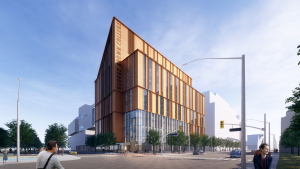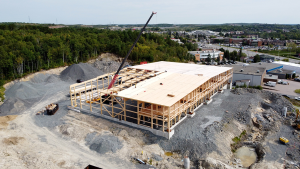Wood is rapidly rising as a material of choice in British Columbia and beyond, but one expert sees benefits not only for the environment but for a building’s occupants.
Graham Lowe is a workplace consultant and the author of Wood, Well-being and Performance: The Human and Organizational Benefits of Wood Buildings, which is a report written for the naturally:wood organization.
It states the use of wood and other natural materials in buildings can be beneficial for the physical and mental health of occupants of those structures.
Lowe writes wood buildings address biophilia, which is the human need for direct connections with nature and natural materials.
“There’s quite a lot of research on the connections we have with plants, greenery, wood and all-natural elements that contribute to very positive physiological, neurological and psychological responses. When you go into a forest or a wooded park that has calming effects,” Lowe said.
“Wood is the next big step in building green. What that means is that people working in a wood structure, for example built with mass timber where the interiors are exposed wood, that environment is going to have a whole range of positive benefits for those occupants,” he said. “Making that direct connection to nature while being inside is a huge plus, given the fact that we spend the majority of our time indoors not outdoors.”
Organizations can also integrate the built environment into their wellness strategies, Lowe said, and those in the wellness space are starting to make the connection between occupant health and the building itself.
“That to me has got huge potential to move an organization’s wellness strategy forward so it’s beyond offering fitness programs and online resources for mental health and safety to actually looking at how we design the space. We are encouraging people to thrive in that physical space,” Lowe said.
People in buildings with exposed wood are far less likely to be absent and they’re far less likely to experience ‘presentee-ism’ which is a bigger cost for an employer and means coming to work when you’re unable to fully function because you’re not feeling well, Lowe said.
“The evidence suggests the reduced rates of absenteeism and presenteeism are huge cost savings and therefore translate into productivity for the employer,” he said.
Recruitment, retention and engagement are also of top concern to many employers and the wood environment in an office contributes to all of those factors, Lowe said.
“What you’ve got is an environment that speaks to the organization’s culture and its brand as an employer. That’s very appealing, especially to younger employees so that’s the recruitment and retention piece but at the same time if people are satisfied with the environment they’re working in that contributes to their sense of engagement with their job, their commitment and their connection,” he said.
While much of the workforce is currently at home due to COVID-19, Lowe said the work from home trend is unlikely to be as pronounced 18 months or two years from now.
“Most employers still recognize the need to have a physical workspace and the internal design of that space may look different with desks spaced out or cubicle farms but having that physical presence and designing the building in a way that speaks to the values of the organization will still be an important feature,” he said.
B.C. is certainly at the forefront when it comes to leading the wood movement, Lowe said, starting with the provincial government’s Wood First initiative in 2009 for all publicly-funded structures and complemented by structures built for the 2010 Olympic Games as well as the 18-storey Brock Commons tower on the University of British Columbia (UBC) campus.
“In addition to putting up these structures, we have expertise at UBC and with manufacturing capacity we have Structurlam, which is a leader for manufacturing components for mass timber buildings. I think B.C. is definitely out front and it still can learn from other jurisdictions and it does,” he said. “The fact that all the building codes in B.C. are permitting up to 12 storeys of mass timber buildings will create quite a surge in tall building construction out of wood,” he said.
For more of Lowe’s interview on the benefits of wood buildings listen to The Construction Record podcast on Nov. 27, https://canada.constructconnect.com/joc/podcasts.
Follow the author on Twitter @JOCFrey.











Coming from a strict employee standpoint, I strongly agree with this article. I find myself not only at work but even in my own home, trying to get a breath of TRULY fresh air, and I don’t mean just going outside you front door. The amount of electronics and technology we now surround ourselves with and the (in my case) constant chemicals being sprayed and used in a enclosed shop, it all adds up and I just really want to get on board with this initiative. Wood is amazing and iI would love to work around it all day, it would really brighten my mood some days.
In my own personal opinion I would much prefer to be surrounded with different wood finishes that I can stare off at during the work day, then being stuck inside a boring grey cubicle with a desk and laptop. I strongly agree with this article, that appearance has more affect on their employees then they might think. When showing up to work everyday you want to be able to enjoy what you do, and part of that is what you see. The aesthetics’s can make or break a work environment, you want your employees to feel as if their working at a desirable place. Absolutely no one wants to work in a bland room, all day/ everyday.
I agree with this article, there are many benefiting factors to wood, it can reduce stress, make you more concentrated and make your brain function better. this is a great thing to be studying further because wood has been used in building for a very long time and it is wonderful to see the benefits it can give to the environment and to our physical health.
I’m more convinced everyday that going green isn’t just an economical decision, but one that seeks to thrust us out of the concrete brutalist structures and gypsum walls for a more natural look. The health benefits of having a healthy space within wood homes is especially relevant, as mentioned in the article, with at home jobs which I believe may be on the rise in the coming years.
I believe that recent trends of unhealthy mental health and physicality can be partially be attributed to the space one resides in, as lower income homes owners that reside in abodes that are not as green and may be made of more cheap and manufactured goods are those stricken with the greatest health problems as well. While not directly correlative, I think it may play into a bigger part of integrating a healthier lifestyle passively which would help that whole situation.
Here’s to a new generation of wood homes that are not more green and sustainable to produce, but also healthier and happier to live in.
This article brings up some very good points, and i think we should take them into consideration. I think its good that were doing more research on the effects of using wood in our building as it is probably the most used material. Learning about the benefits really opened my eyes on how wood is just beneficial for building but its occupants living inside
I believe that Wood is good for our health. Research is showing that incorporating wood and other natural materials into our buildings can reduce stress and contribute to good mental health. Bringing nature indoors through exposed wood and other natural materials can have a positive impact on our health. Employees surrounded with natural wooden surfaces on average reported higher personal productivity, mood, concentration, clarity, confidence and optimism and were more likely to find their workplaces relaxing, calming, natural feeling, inviting and energizing. almost half of employees who work indoors spend less than an hour outdoors on work days. This is of concern given the long-established connection between well being and spending time in nature, especially amid the increasing urbanization of populations
Great article! As someone who has always felt a deep connection to nature you really opened my eyes on the biophilia hypothesis. Just because we have evolved and developed technology doesn’t mean that we’ve lost our innate need for nature. It really is a shame that in typical buildings all the beautiful and natural wood is concealed behind drywall, I think if we had more wood buildings we’d truly have a greater appreciation for nature.
I agree with this article, being in workspaces that feel lifeless and stuffy make it hard to want to return daily. Appreciating your workspace for its feel and design goes a long way. It is a bonus that it also happens to be a greener building practice. Though the technology today is quite engaging, it is nice to get away from it and feel more connected to nature. So, in the sense of working in buildings constructed this way it is a compromise between the two.
The article makes an interesting point regarding the value of wood buildings. The feeling of being in nature helps employees feel better and focus on their jobs. Using natural elements are important as we move to green building methods. Creating spaces where employees feel they can do their best work and increase productivity is beneficial to the organization. British Columbia is taking an active role in changing the work spaces and improving the health of their citizens. Ontario should follow BC’s example and begin to use wood buildings more.
I strongly agree with this article because wood is fun to work with and i believe that if we can continue to grow trees as fast or even faster then how much we use then i think we can continue to build and make whatever we want with the materials. i just cant wait to build my own wood shop at home and begin building small tables from some random pieces of wood that nobody cared about. i know from past times that my stress levels are at the lowest of lows when im planning a big piece of wood that i know will turn into a shelf or a night stand. That’s the beauty of wood, taking something and being creative enough to turn it into something crazy.
I personally agree with this article, for one, there is a relaxing sensation to being around nature and having an exposed timber interior would definitely give you that feeling. Secondly it’s a lot healthier for people to work in buildings with exposed wood because it reduces the chances of the workers getting sick and not being able to work. I personally like the way B.C moved to only wood structures because the benefits are better in the long run.